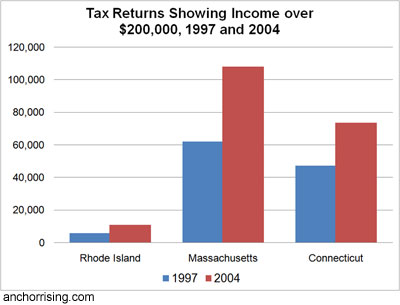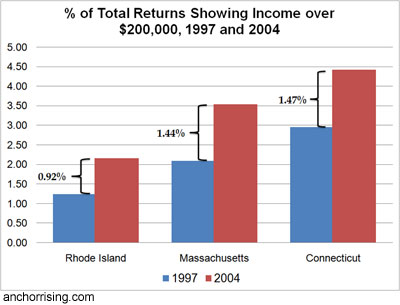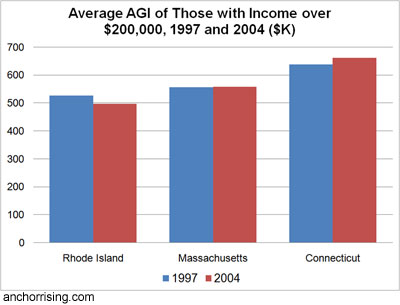February 5, 2008

Lying Down the Line
Readers familiar with NEA Assistant Executive Director Patrick Crowley's body of work are to be forgiven if they took the opening line of the letter to the editor that he's been passing around to all the local papers — "repeat the lie, no matter how false it is" — as advice, not a complaint. Dan Yorke did a much better job dissecting Crowley's Newsmakers appearance than I did, but the take-away is the same — namely, that Crowley's professional objective is to get away with as much twisting, stretching, and convenient misspeaking of the truth as he can. Of especial interest with his latest offering, however, is how much help he has.
Crowley's letter (which is not available online) is nothing more than a distillation of a recent report (PDF) published by the Poverty Institute at the Rhode Island College School of Social Work (and hosted on a Web site, incidentally, that is registered using a RIC address). The Poverty Institute, in turn, gets some of its key data from the Institute of Taxation and Economic Policy (ITEP), a Washington think tank funded by a long list of progressive foundations — in conjunction with the National Education Association.
I offer this information not to cast a cloud of innuendo about broad progressive conspiracies to fleece the Rhode Island taxpayers of their money, but because it is a critical consideration when observing how the Poverty Institute research document and Crowley's letter are constructed. Point by point (from the Poverty Institute):
- "The number of very high income Rhode Islanders is growing." This is really the credibility hook (so to speak) for the entire study, because the data comes from the IRS. As I'll show in a moment, however, the progressives' use of it is (surprise, surprise) misleading.
- "Incomes at the top are rising rapidly." This is the jealousy-evoking component, meant to help the reader toward the conclusion that wealthy taxpayers can afford to be taxed more. It's also the component that comes directly from ITEP, using (as far as I can tell) an untraceable methodology that allows an opposite conclusion than the data used for the first point.
- "More affluent taxpayers move to Rhode Island from Massachusetts than move from Rhode Island to Massachusetts." The Poverty Institute turns back to the IRS to bolster its point, but using data that is not easily accessible and offering little by way of actual numbers.
- "Charitable contributions by affluent residents have been stronger in Rhode Island than in neighboring states." The last claim is also meant to bolster the more significant openers, it is also from hard-to-access IRS data, and the data is also limited, inasmuch as the Poverty Institute provides only percentage differences from year to year, without any context as to what those percentages signify.
Here's how Crowley presents the first point:
The number of very high-income Rhode Islanders is growing. Using data (that is, real numbers) from the IRS, the Poverty Institute shows that between 1997 and 2004, the number of people with incomes over $200k rose 87 percent, more than Massachusetts and Connecticut.
Of itself, the claim is true enough. The IRS processed 5,064 more RI tax returns with over $200,000 in income in 2004 than 1997. But the related increases were 46,059 tax returns in Massachusetts and 26,433 in Connecticut.

Our neighbors are larger, though, so consider that households over $200,000 accounted for 2.16% of total returns in RI, 3.53% in Massachusetts, and 4.42% in Connecticut. Over the eight years in question, an additional 0.92% of Rhode Island households entered the highest income group. Massachusetts pulled up an additional 1.44%, and Connecticut 1.47%.

Incomes at the top are rising rapidly. In 2005, the highest earning 1 percent of Rhode Island households earned $965,908, an 11.9 percent increase from 1999.Income for the elite rich rose faster than neighboring Connecticut and Massachusetts. Elites in Connecticut had their incomes rise by 5.3 percent and in Massachusetts they actually dropped by 4.2 percent between 1999 and 2005.
As I've said, this sources directly to ITEP, not the IRS, with no public data in a form that can be analyzed. The time span switches to 1999–2005, and the group under the microscope is now the top 1%, not those over $200,000. Not having access to the data, I can't guess the reasons for these differences.
It's interesting, however, that the Poverty Institute report shows that the top 1%'s average 2005 income of $965,908 represented a $113,705 leap from 2003 and was $115,908 higher than the 1999-2003 average. Whether the sudden spike was a fluke or a trend, I guess we'll see. Although, I doubt that progressives' tax-the-rich schemes will help to make it the latter.
Whatever the case, sticking with the IRS data already on the table, one finds that the average gross income (AGI) of those in the top earning category ($200,000+) was down 5.79% in 2004 from 1997 in RI. In MA, it was up 0.52%, and in CT, it was up 3.85%.

IRS data shows that Rhode Island is attracting more affluent people. Migration data based upon state of residency on tax returns show that more people are moving from Massachusetts to Rhode Island than the reverse.
It's suspicious that this is the only claim for which the Poverty Institute provides no illustrations — as if they wish the point to be made, but not considered. I'll take the Institute at its word that "the median income of in-migrants from Massachusetts has been higher than the median income of out-migrants to Massachusetts," although as an editor, I wonder whether "has been" means "has been consistently" or "has, at times over this period, been." As an intellectually curious fellow, it strikes me as odd that we're suddenly talking "median income," and I find it particularly peculiar that the only actual numbers come from the following:
This is true despite the fact that MA reduced its top income tax rate from 5.95 to 5.3 percent in 2000-2002 while Rhode Island’s top marginal rate at the time was 9.9%.
We've got quite a jumble of years, here. As I understand it, Massachusetts then raised its top rate, while Rhode Island lowered its rates. For these reasons, I'm confident that an analysis of the raw numbers would actually support the opposite argument from that which Crowley & Co. wish to make. Back to him:
Charitable contributions from the elite have rebounded better in Rhode Island than Connecticut and Massachusetts from the post-911 recession.
Based on the analysis above (not to mention long experience), it's easy to understand why readers ought to be wary of the Poverty Institute's presentation of percentages of increase and decrease. They give no dollar-amount basis for judging. Whatever the case, the overarching point is perverted: that Rhode Island's wealthy are particularly generous and therefore must be able to afford having more of their money taken by force of law.
I suspect that the Progressive Conspiracy's sky-ain't-falling points will become narrower and narrower as data approaching 2008 becomes available. Perhaps then they'll let their stripes show and declare victory over the rich.
ADDENDUM:
I've corrected a misfire of the synapses: The latter date in all of the above charts should have been 2004 — same data, different label — so I've fixed the problem.
Couple of points.
First, let's look at the reality behind this quote: "Incomes at the top are rising rapidly. In 2005, the highest earning 1 percent of Rhode Island households earned $965,908, an 11.9 percent increase from 1999." Since we're talking about averages and the top 1%, the truth boils down to three words: Providence Equity Partners. Before the General Assembly takes La Kate and Crowley's suggestion to raise taxes on the evil rich, they might want to have Jonathan Nelson and his partners around for a drink to see if they'll stay in RI and take the higher tax hit.
Then we have this beauty: "Charitable contributions from the elite have rebounded better in Rhode Island than Connecticut and Massachusetts from the post-911 recession." Let me give you a quantitative example of what this means: an increase from $1 to $2, on a percentage basis, is much greater than an increase from $15 to $16. However, if I was a charitable organization seeking private sector funding, I'd ranther be in the latter state. What Brewster and Crowley fail to note is that when it comes to the dollar value of charitable giving, RI remains in the national cellar, and far below Massachusetts.
Wonder how much of the putative increase in rich incomes is due to one-time capital gains on residences sold to move tax residency to MA or FL?
Posted by: Ragin' Rhode Islander at February 5, 2008 11:01 AMJustin,
I am all for getting the numbers right. If you can expose misleading or fraudulent numbers in other people's presentations, I'm with you 110%.
I haven't gotten through your entire post yet, because I got hung up on table 2. Please tell me if I've got this right. Sorry I can't do a real table.
Percentage of Returns Showing Income over 200K
RI 1997 1.24% 2003 2.16%
MA 1997 2.09% 2003 3.53%
CT 1997 2.96% 2004 4.43%
Then you subtract the 1997 rate from the 2003 rate, and say that RI got an additional .92%, while MA rose 1.44% and CT 1.47%. That makes it look like the number of $200K+ returns increased at a slower rate than the other states.
However, the percentage changes in the percentages ((2003 percentage-1997 percentage) /1997 percentage) are:
RI +74%
MA +69%
CT +50%
It thus appears that the percentage of $200K+ returns grew at a faster rate in RI than either of our neighbors.
Nothing like using a second derivative to justify a tax increase on the evil rich, eh Chalkdust?
Posted by: John at February 5, 2008 12:06 PMChalkdust.
You're correct; that's the point made by Crowley et al. It's misleading, though, because wealthy people don't grow like vines. They're made or imported. It's misleading to look at the growth rates when your underlying argument is that we can increase the burden, for them, of living in Rhode Island.
Look at it this way: If you've got $10 and I give you $5, then your wealth has increased by 50%. If I then give $500 to somebody who has $10,000, his wealth has only increased by 5%. Wouldn't it be misleading of me to use these percentages to argue that you should give me a dollar back?
Not only is Rhode Island significantly out of step with its enclosing neighbors when it comes to percentage of wealthy residents, but it isn't adding as large a percentage of its population to this group. Consider the percentages as steps: If MA starts an incremental race one step ahead of RI and, over a period of time, takes one and a half steps, while RI takes less than one step, is that evidence that RI is even keeping pace?
Posted by: Justin Katz at February 5, 2008 12:30 PMJohn,
I give Justin credit for having the intellectual integrity to want to get it right. He generally doesn't label me as "hate the rich" just because I offer an argument. I wish you would follow suit. I thoroughly enjoyed the discussion with you in the sales tax thread, where you stuck to facts and arguments. Neither my goals, of which you know nothing, or my attitude toward wealthy people (how do you know I'm not one?) are relevant. I just want to get it right too, So could we stick to the point here as well? If you think I'm wrong, say why and skip the insults and attributed motives, please.
That point, the only one I raised at least, is whether Justin's representation of the change in >$200K earners in his chart is fair and accurate, or misleading. I think it's misleading because it makes it appear as though the proportion or Rhode Islanders earning more than $200K is increasing at a slower rate than MA or CT, when the opposite is true.
It remains the case that the proportion of Rhode Islanders earning more than $200K increased at a faster rate than did the proportion in MA and CT. Of course, that is one fact among many that is important here, but it remains a fact.
Posted by: Chalkdust at February 5, 2008 1:59 PMGreat post, Justin.
Some quick points.
> Loved the use of the term "elite".
> Stipulating for a moment whatever narrow point they are trying to make, exactly how much of an actual increase in revenue does it equate to and over what period of time? Their point may sound good but does it even come close to the amount that state spending has risen by or to the amount of spending that the PI wants it to rise by?
> When the trend of earners over $200,000 goes the other way, will the Poverty Institute start calling for a reduction in taxes and spending (in the fourth highest taxed state in the country)?
Posted by: Monique at February 5, 2008 5:15 PMChalkdust.
But it's easier to almost double 1% than 2%, and you haven't explained why, intellectually or on principle, it is more appropriate to measure the rate, in this case, by the percentage growth of the group, rather than by the percentage of the population that was added to the group.
Note, by the way, how close the added percentages (my measure) are between MA and CT.
Back to Excel; stay tuned.
Posted by: Justin Katz at February 5, 2008 5:23 PMTruly, I would love to see income tax on "the rich" doubled to 20%, sit back with some beer and popcorn and look at the "progressive" pyramid crumble over the next few years.
How did that cigeraate tax doubling work out for ya progressives? LOL.
